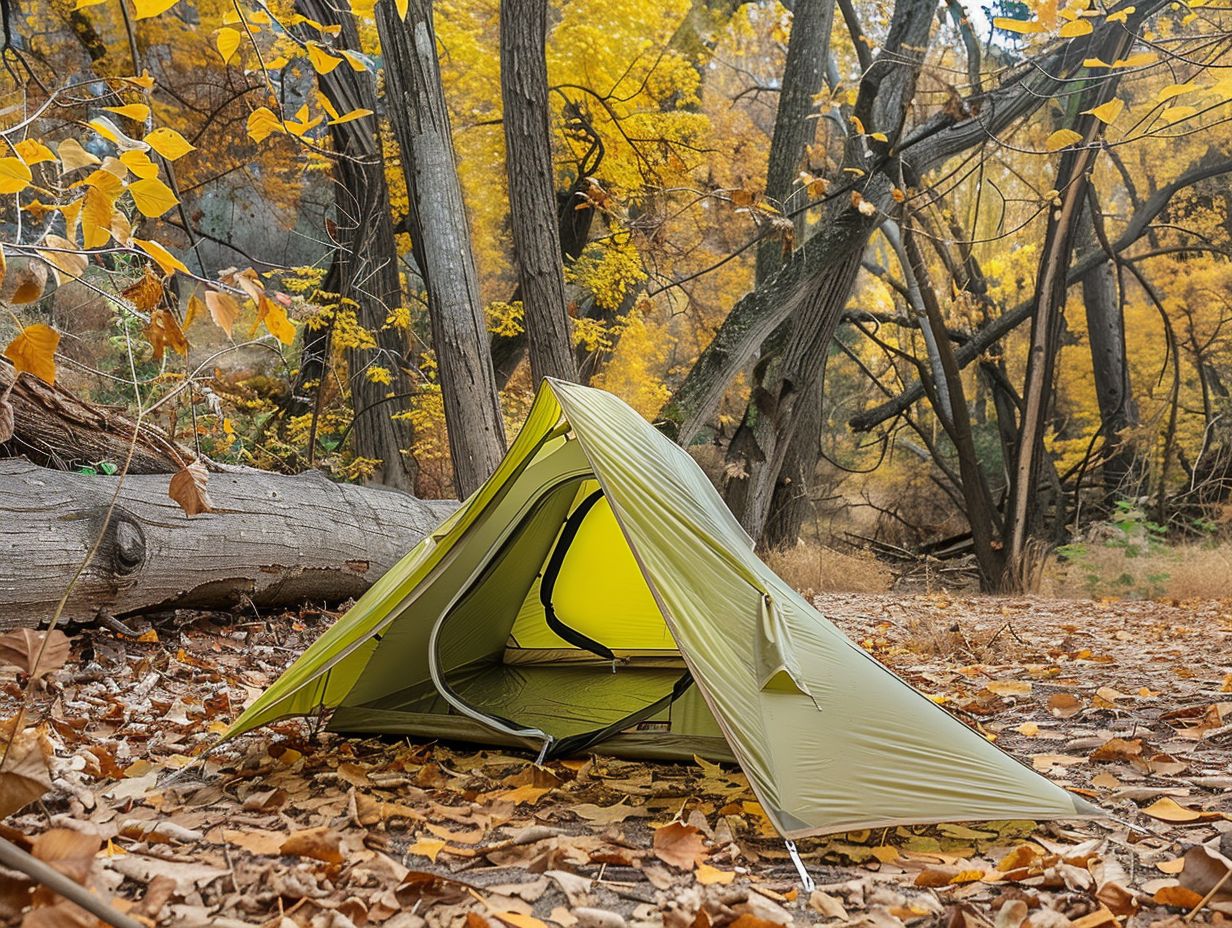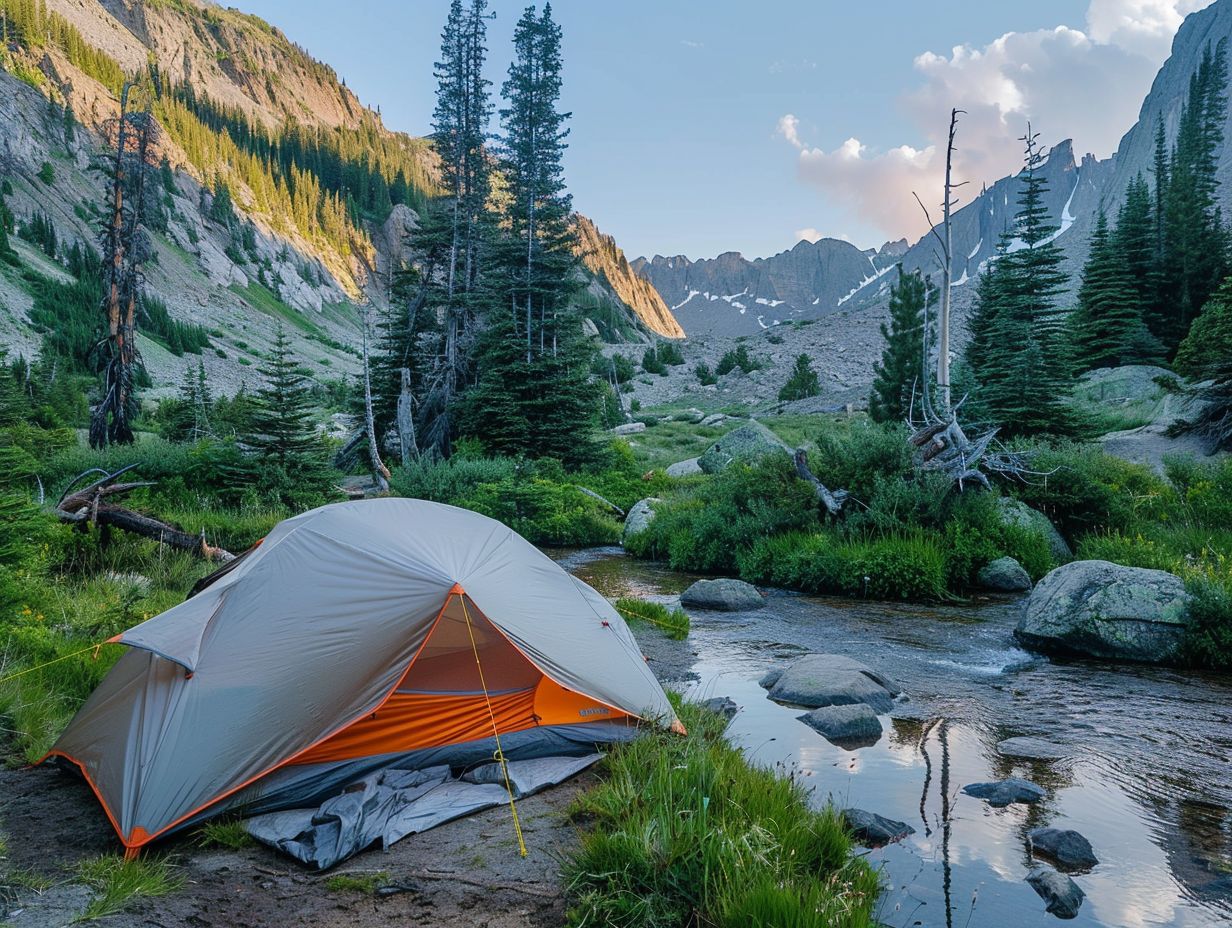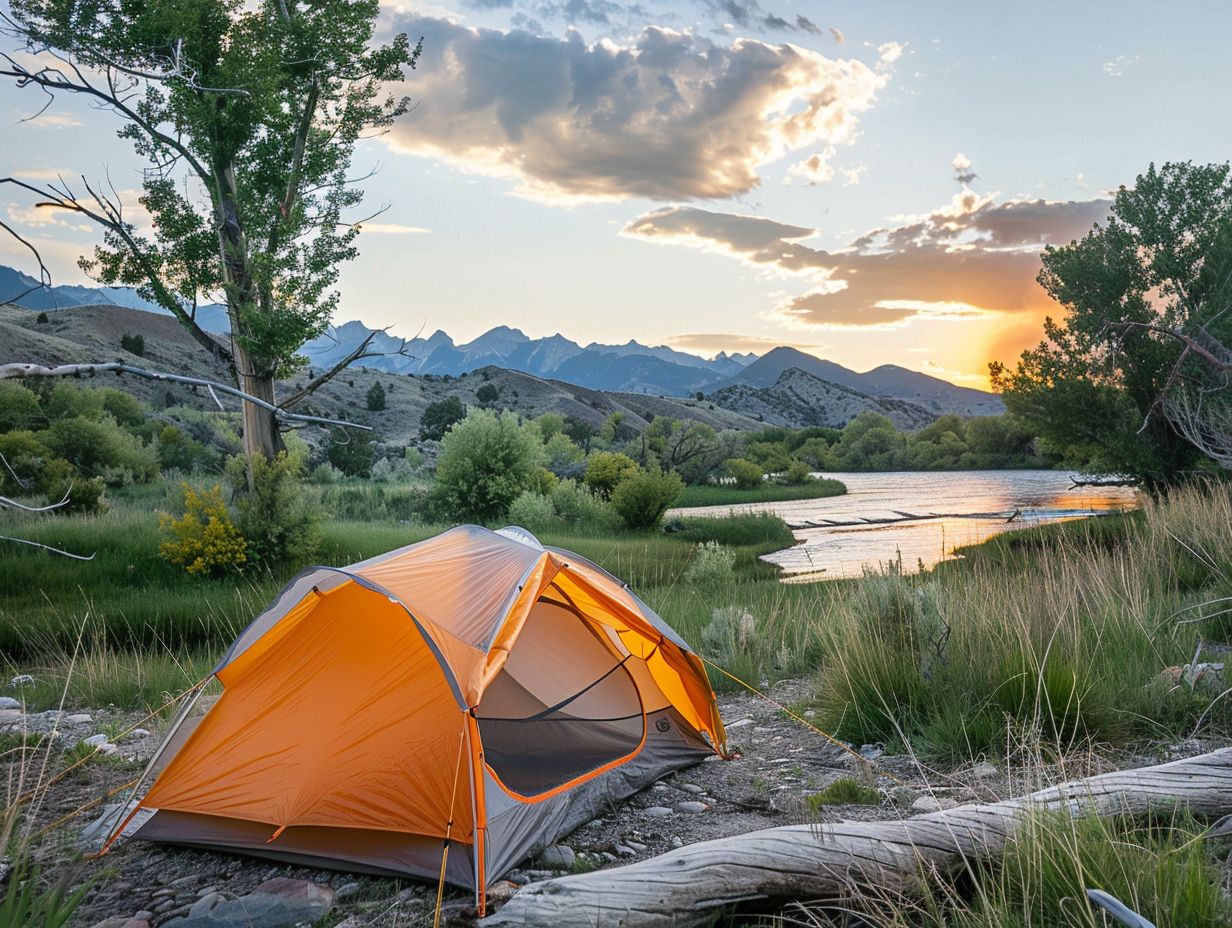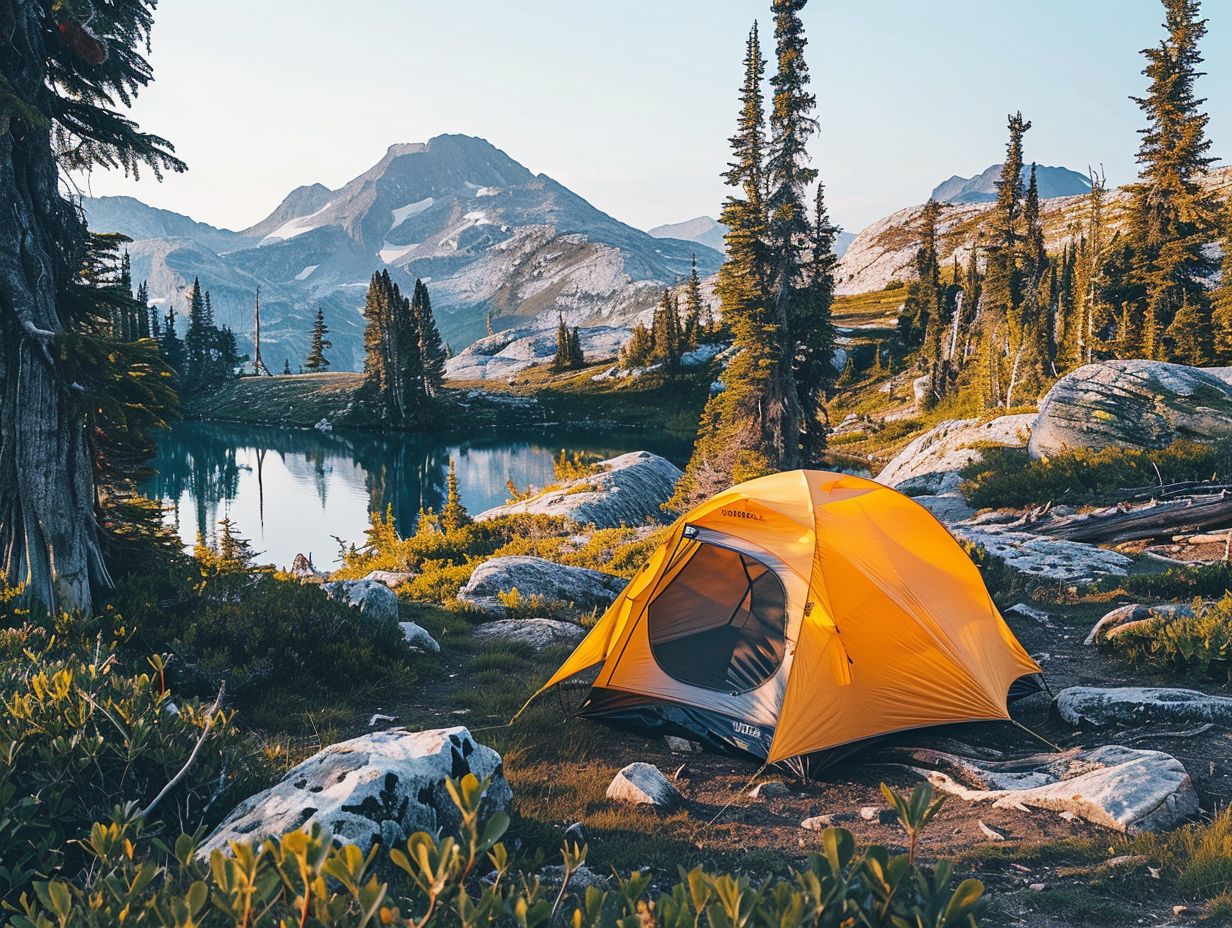Are you an avid backpacker in search of the ideal lightweight tent for your upcoming adventure? Look no further!
This article presents a compilation of the top 10 lightweight tents that are specifically designed for backpacking enthusiasts. The list includes popular choices such as the Big Agnes Copper Spur HV UL2 and the Nemo Hornet Elite 2.
Furthermore, valuable tips are provided on how to effectively maintain and care for your lightweight tent, ensuring its longevity for numerous future adventures.
For those who seek to enhance their backpacking experience, it is recommended to continue reading to discover more about these top lightweight tent options.
Key Takeaways:

- The Big Agnes Copper Spur HV UL2 is the top choice for lightweight and durable backpacking tents.
- Proper care and maintenance, such as regular cleaning and storage, can extend the lifespan of your lightweight tent.
- The Nemo Hornet Elite 2 and MSR Hubba Hubba NX offer a balance of weight, durability, and livability for backpackers.
Top 10 Lightweight Tents for Backpacking
Regarding backpacking, you need to ensure you have the right lightweight tent that offers optimal design, weight, and space efficiency for your camping trips. There are several options available, such as the ultralight NEMO Hornet OSMO 3, the spacious Big Agnes Tiger Wall 2, and the innovative Zpacks Duplex, each providing quality construction, ample interior space, and reliable weather protection.
The NEMO Hornet OSMO 3 tent is designed with a tapered floor to maximise space efficiency while maintaining durability. It offers decent headroom for comfortable movement inside and is quick and easy to set up, making it a great choice for solo backpackers.
In contrast, the Big Agnes Tiger Wall 2 features dual doors and vestibules for convenient access and gear storage. Its freestanding design allows for versatile pitching options, adding to its appeal.
Finally, the Zpacks Duplex stands out for its ultralight construction, utilising Dyneema fabric for exceptional strength-to-weight ratio. It also offers excellent ventilation to address condensation concerns, making it a top choice for backpackers looking for a reliable shelter option.
1. Big Agnes Copper Spur HV UL2
The Big Agnes Copper Spur HV UL2 is an excellent choice for backpackers in search of an ultralight tent that maintains high quality and functionality. This tent boasts a spacious yet lightweight design that is both easy to set up and durable, perfect for outdoor expeditions.
Its innovative hub design maximises interior space without sacrificing weight, catering to individuals who prioritise comfort without added bulk. Setting up the tent is a straightforward process, aided by colour-coded poles and clips that enable quick pitching even in challenging conditions. The tent’s ventilation is outstanding, featuring dual-zipper doors and multiple mesh panels that facilitate airflow while preventing insects from entering.
Priced competitively against other premium ultralight tents, the Copper Spur HV UL2 distinguishes itself with its optimal balance of weight, quality, and functionality.
2. Nemo Hornet Elite 2
The Nemo Hornet Elite 2 is a popular choice among backpackers for its ultralight construction using Dyneema Composite Fabric, providing a roomy interior space with excellent ventilation, all at a reasonable price point.
The Nemo Hornet Elite 2 stands out for its innovative design features, such as an asymmetrical shape to maximise headroom and interior space. The strategic placement of vents ensures optimal airflow, preventing condensation buildup even in humid conditions. This tent’s attention to detail extends to the durability of its materials, making it a reliable shelter for various outdoor adventures.
When compared to other tents in its category, the Nemo Hornet Elite 2 strikes a balance between weight and cost, offering backpackers a high-performance option without breaking the bank.
3. MSR Hubba Hubba NX
The MSR Hubba Hubba NX is well-known for its spacious interior space, comfortable headroom, and robust construction that provides exceptional weather protection for backpackers in diverse outdoor environments.
The symmetrical pole design not only optimises living space but also reinforces the tent’s stability in windy conditions. With two large doors and vestibules that offer easy entry and ample storage for equipment, the tent enables convenient movement for two occupants.
The colour-coded clips and poles streamline the set-up process, saving time and reducing hassle. Compared to similar tents in its category, the Hubba Hubba NX stands out for its combination of spaciousness and weather resistance, ensuring a pleasant camping experience.
4. REI Co-op Quarter Dome SL 2
The REI Co-op Quarter Dome SL 2 offers you generous floor dimensions, a roomy interior, and a lightweight design that makes it easy for you to set up, catering to backpackers who prioritize comfort and space without compromising on weight.
With a floor area of 28.7 square feet, this tent comfortably accommodates two people with ample space to move around. Weighing in at just over 3 pounds, it is incredibly lightweight and compact, making it perfect for ultralight backpacking adventures.
The setup process is streamlined with color-coded clips and poles, allowing for a hassle-free pitching experience. One standout feature is the unique rainfly design that maximizes ventilation and provides excellent protection from the elements.
The REI Co-op Quarter Dome SL 2 strikes the perfect balance between durability, spaciousness, and ease of use.
5. Zpacks Duplex

When selecting a tent for your backpacking needs, the Zpacks Duplex stands out as an excellent choice. Constructed with Dyneema fabric, this tent offers a lightweight and durable option for backpackers. The Zpacks Duplex Zip feature allows for easy setup, ensuring a hassle-free experience.
The Dyneema fabric used provides exceptional strength-to-weight ratio, making the Zpacks Duplex both durable and lightweight, ideal for your backpacking adventures. Despite its premium qualities, the Zpacks Duplex is competitively priced, offering great value for its quality.
Additionally, its innovative design elements, such as dual doors and vestibules, provide enhanced ventilation and ample storage space, distinguishing it from other lightweight tents on the market.
In comparison to similar tents, the Zpacks Duplex strikes a balance between superior quality and affordability, making it a top choice for outdoor enthusiasts like yourself.
6. Sierra Designs Flash 2
The Sierra Designs Flash 2 tent offers a spacious interior with excellent ventilation, making it a budget-friendly option for backpackers seeking a reliable shelter that offers ample room and comfort, all while being easy to set up. With its two-door, two-vestibule design, the Flash 2 ensures convenient access and additional storage space for gear without compromising livable space.
The tent’s strategic mesh panels and windows promote airflow, ensuring good ventilation even in warm conditions. The setup process is made easier with colour-coded poles and clips, allowing for a quick pitch after a long day of hiking. Priced affordably, this tent is a solid choice for adventurers looking for a balance between cost-effectiveness and functionality.
7. Marmot Tungsten UL 2
The Marmot Tungsten UL 2 is designed to provide you with reliable weather protection, as it combines lightweight materials with high-quality construction to offer backpackers a spacious and secure shelter for their outdoor excursions.
The tent comes equipped with robust aluminium poles that provide strength and stability in windy conditions, ensuring that you remain protected even in challenging weather. Its twin doors allow for easy entry and exit, and the vestibules offer additional storage space for your gear.
With a trail weight of just under 4 pounds, the Tungsten UL 2 is easy to carry during long treks. Internally, the tent features ample headroom and floor space, making it comfortable for extended stays in the outdoors.
8. The North Face Stormbreak 2
The North Face Stormbreak 2 is an affordable and user-friendly option for backpackers like yourself, providing easy setup, dependable weather protection, and a comfortable interior. This makes it a sensible choice for outdoor enthusiasts who are conscious of their budget.
It is notable for its simple and efficient assembly process, featuring colour-coded poles and an intuitive design that enables you to pitch the tent swiftly and effectively, even in challenging weather conditions.
The Stormbreak 2 excels in its ability to withstand adverse weather, showcasing a sturdy rainfly and waterproof materials that ensure campers remain dry during rainy nights. Campers particularly value the roomy interior, which comfortably accommodates two individuals.
In comparison to other tents within its price range, the Stormbreak 2 strikes a harmonious balance between affordability and quality, establishing itself as a favoured option for individuals seeking a dependable and user-friendly shelter.
9. Big Sky International Soul 2P
The Big Sky International Soul 2P distinguishes itself with its floorless design, lightweight construction, quality materials, and spacious interior, providing a distinctive camping experience for backpackers seeking a minimalist yet roomy tent.
The floorless aspect of the tent not only minimizes weight but also permits versatile setups to adapt to various terrains and preferences. By utilising premium materials, the tent achieves durability without sacrificing weight, making it well-suited for extended backpacking excursions.
Despite its lightweight build, the Soul 2P offers ample interior space, accommodating two campers comfortably and allowing for gear storage. The floorless design caters to backpackers valuing simplicity, adaptability, and the opportunity to connect with nature while ensuring protection.
10. Six Moon Designs Lunar Solo
The Six Moon Designs Lunar Solo is a highly regarded option for backpackers looking for a lightweight tent that boasts quality construction, easy setup, ample space, and an affordable price point, making it a popular choice among solo adventurers.
Setting up the Lunar Solo is a straightforward process, thanks to its uncomplicated single-pole design and user-friendly pitch system. Its cost-effectiveness, especially when compared to other lightweight solo tents available in the market, is worthy of note, offering excellent value for the range of features it provides.
Despite its lightweight build, the Lunar Solo doesn’t compromise on space, providing sufficient room for one person to sleep comfortably and store gear.
The meticulous attention to detail in its construction quality, including reinforced stitching and durable materials, distinguishes it in terms of durability and dependability when compared to similar tents.
How to Properly Care for Your Lightweight Tent

Taking care of your lightweight backpacking tent is vital to ensure its longevity and performance during camping trips. Proper cleaning, drying, storage techniques, regular repairs, and maintenance routines are essential to prolong the lifespan of your shelter.
After each camping excursion, you should initiate the process by delicately removing any dirt, debris, or stains from the tent fabric using a mild soap solution and a sponge. It is advisable to refrain from using harsh chemicals that may potentially harm the material.
Upon completion of the cleaning process, it is imperative to allow the tent to air dry thoroughly in a shaded area to prevent the growth of mould and mildew. Regarding storing your tent, it is recommended to avoid compressing it too tightly in its stuff sack, as this could potentially damage the fabric’s waterproof coating. Opting for hanging or loosely packing the tent in a cool, dry location is preferred to maintain its shape and structural integrity.
Regular inspections of the tent for tears, loose seams, or zip issues are crucial, and any identified problems should be promptly addressed using a repair kit to prevent further damage.
To ensure that your tent remains in optimal condition, it is advisable to consider regularly reapplying waterproofing treatments in accordance with the manufacturer’s recommendations to preserve its water resistance.
Cleaning and Drying
Properly cleaning and drying your lightweight tent after each use is essential for preventing the development of mould, mildew, and odours, ensuring that it remains fresh and prepared for your next backpacking expedition.
To commence the cleaning procedure, start by eliminating any debris or dirt from the tent by gently shaking it out or using a soft brush. Following this, prepare a large container filled with lukewarm water and a mild soap specifically formulated for outdoor gear. Use a sponge or cloth to delicately scrub the tent, eliminating any stubborn spots or stains. Exercise caution around delicate areas such as seams and zippers to prevent damage.
For more stubborn stains, carry out spot treatment with a mild stain remover recommended for outdoor fabrics, adhering to the manufacturer’s guidelines.
Avoid using bleach or harsh chemicals that could weaken the fabric. Subsequently, rinse the tent meticulously with clean water to eliminate all traces of soap. Hang the tent in a well-ventilated area to air dry thoroughly, avoiding direct sunlight as it may harm the fabric.
Ensure the tent is entirely dry before storing it to avert mould growth. Consistent maintenance and proper cleaning practices will extend the lifespan of your tent, ensuring it remains in optimal condition for numerous outdoor excursions.
Storage
Proper storage of your lightweight tent when it is not in use is crucial for extending its lifespan. To optimise storage conditions, it is important to keep the tent dry, shielded from direct sunlight, and protected from pests or moisture to prevent any damage and preserve its structural integrity. It is essential to avoid common storage mistakes such as folding the tent while it is damp or dirty, as this can result in mould growth and fabric deterioration.
To provide additional protection for your tent, it is advisable to consider investing in a breathable storage bag that allows for air circulation, thus preventing musty odours or mildew. For long-term preservation and readiness for your next outdoor excursion, storing the tent in a cool, dry location away from extreme temperatures is recommended. This practice will help prolong the tent’s usability and ensure that it remains in optimal condition.
Repairs and Maintenance
Regular repairs and maintenance checks are crucial for addressing any tears, leaks, or damage to your lightweight tent promptly to ensure it remains in optimal condition for your next outdoor excursion.
When inspecting your tent for damages, start by examining the seams for any signs of wear or tearing. Use a seam sealer to reinforce any weak spots and prevent water from seeping through.
Regularly checking the zips is also essential; lubricate them with silicone spray to keep them functioning smoothly. If you come across a tear, patch it up using a repair kit specifically designed for tent materials. To be prepared for emergencies, pack a small sewing kit, extra guy ropes, and spare tent poles in your backpacking gear.
Remember, proper care and maintenance will extend the life of your tent and ensure a comfortable camping experience.
Tips for Extending the Lifespan of Your Tent
To extend the lifespan of your lightweight tent, it is recommended that you implement certain practices. These include using ground sheets, avoiding contact with sharp objects, correctly pitching the tent, and adhering to the care and maintenance guidelines provided by the manufacturer.
When choosing a camping spot, it is advisable to select level ground that is free from rocks or debris to minimise the risk of abrasions. Additionally, it is important to consider factors such as wind direction and potential hazards like falling branches or uneven terrain.
During the setup process, it is crucial to ensure that all guy ropes are taut to evenly distribute tension across the fabric. Regularly inspecting and cleaning your tent can help prevent the build-up of mould or mildew, which can weaken the material over time.
Taking a proactive approach by promptly addressing minor tears or loose seams can help prevent the need for more extensive repairs in the future, ultimately prolonging the durability of your tent while out on the trail.
Frequently Asked Questions
What are the benefits of using the best lightweight tents for backpacking?

The best lightweight tents for backpacking offer several benefits, including reduced pack weight, easier portability, and better breathability for warmer weather. They also tend to be more compact and streamlined, making them ideal for backpacking trips where space is limited.
How do I choose the right size for a lightweight backpacking tent?
When choosing a lightweight backpacking tent, consider the size and number of people who will be using it. Most tents are designed to accommodate a specific number of people, so make sure to check the capacity before purchasing. It’s also a good idea to consider the dimensions and height of the tent to ensure it can comfortably fit all occupants.
What materials are best for lightweight backpacking tents?
The best lightweight backpacking tents are typically made with lightweight materials such as nylon, polyester, or cuben fiber. These materials are durable, water-resistant, and can withstand the rigors of backpacking trips. It’s also important to look for tents that have lightweight but strong poles and sturdy zippers.
Do I need to sacrifice durability for lightweight when choosing a backpacking tent?
Not necessarily. While lightweight materials may not be as heavy-duty as traditional tent materials, they can still be durable and reliable. Look for tents with reinforced areas, double-stitched seams, and high-quality materials to ensure they can withstand the elements and last for multiple trips.
How much should I expect to spend on the best lightweight tents for backpacking?
Prices for the best lightweight tents for backpacking can vary greatly, depending on the brand, size, and features. Typically, you can expect to spend anywhere from $100 to $500 for a high-quality lightweight backpacking tent. It’s important to consider your budget and the features you need before making a purchase.
Are there any additional features I should look for in a lightweight backpacking tent?
Some other features to consider when choosing the best lightweight tent for backpacking include multiple entrances for easy access, gear storage pockets, and adjustable vents for improved ventilation. You may also want to look for tents with a rainfly or footprint for added weather protection and durability.



